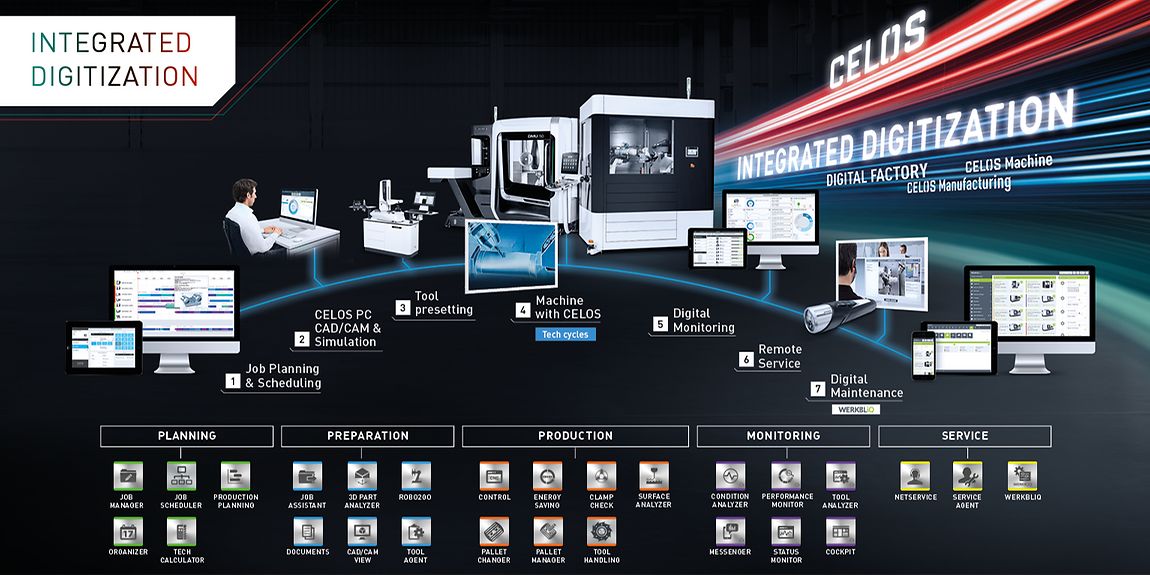 Metal cutting used to be about making chips, but in modern manufacturing it is just part of the story. In today's digital world, metal might be a product's core component, but data is the raw material that drives improvement.
Metal cutting used to be about making chips, but in modern manufacturing it is just part of the story. In today's digital world, metal might be a product's core component, but data is the raw material that drives improvement.
That was clearly the case at DMG Mori's Chicago Innovation Days held May 13-16 at the company's Hoffman Estates, IL, facility. Amid the dozens of multi-axis, high-production equipment showcased during the event, including the two machines making their U.S. premiers, the concept of "integrated digitization" was clearly evident as visitors were greeted with large signage that detailed a "path of digitization." This path incorporated planning, monitoring and servicing of design, production, analysis, serving and more. It showed how machines, both DMG and 3rd-party equipment, processes, and services can work together in a paperless environment to efficiently produce finished goods.
This map was brought to life, in miniature, with a series of interconnected machinery. Visitors were able to take 1-hour long walking tour of the connected "factory" presentation that traversed from machine station to machine station detailing the open-connectivity concept. Machinery included the DMU 50, a 5-axis CNC Universal Milling Machine, the NTX 1000, an integrated mill turn center for complex-shaped workpieces, the CMX 1100V, a vertical machining center, and the ULX 2500 Universal CNC turning machines.
Each machine showcased different capabilities of an interconnected factory such as real-time machine condition monitoring such as tool spindle health. The company's easy-to-use Celos system features 27 applications, including 11 new apps, that cover various levels of the process. These levels include: Planning that is used for production planning and control and assisting with job processing; Preparation for production support, conversion tools and access to reference material; Production for intelligent energy management and individual configuration of all apps; Monitoring for detailed machine and order status display, live, real-time status; and Service that is a maintenance and service assistant, and can be linked to online support.
J.J. Chuang, general manager, DMG Mori Software Technology Solutions USA, part of DMG Mori USA, said that paperless, digital connectivity can make for the best utilization of a machine tool. The technology makes for a "visible and transparent," factory, he said, and allows for data analysis and system monitoring that can resolve problems before they even occur and prevent downtime.
Contact Details
Related Glossary Terms
- computer numerical control ( CNC)
computer numerical control ( CNC)
Microprocessor-based controller dedicated to a machine tool that permits the creation or modification of parts. Programmed numerical control activates the machine’s servos and spindle drives and controls the various machining operations. See DNC, direct numerical control; NC, numerical control.
- gang cutting ( milling)
gang cutting ( milling)
Machining with several cutters mounted on a single arbor, generally for simultaneous cutting.
- machining center
machining center
CNC machine tool capable of drilling, reaming, tapping, milling and boring. Normally comes with an automatic toolchanger. See automatic toolchanger.
- milling
milling
Machining operation in which metal or other material is removed by applying power to a rotating cutter. In vertical milling, the cutting tool is mounted vertically on the spindle. In horizontal milling, the cutting tool is mounted horizontally, either directly on the spindle or on an arbor. Horizontal milling is further broken down into conventional milling, where the cutter rotates opposite the direction of feed, or “up” into the workpiece; and climb milling, where the cutter rotates in the direction of feed, or “down” into the workpiece. Milling operations include plane or surface milling, endmilling, facemilling, angle milling, form milling and profiling.
- milling machine ( mill)
milling machine ( mill)
Runs endmills and arbor-mounted milling cutters. Features include a head with a spindle that drives the cutters; a column, knee and table that provide motion in the three Cartesian axes; and a base that supports the components and houses the cutting-fluid pump and reservoir. The work is mounted on the table and fed into the rotating cutter or endmill to accomplish the milling steps; vertical milling machines also feed endmills into the work by means of a spindle-mounted quill. Models range from small manual machines to big bed-type and duplex mills. All take one of three basic forms: vertical, horizontal or convertible horizontal/vertical. Vertical machines may be knee-type (the table is mounted on a knee that can be elevated) or bed-type (the table is securely supported and only moves horizontally). In general, horizontal machines are bigger and more powerful, while vertical machines are lighter but more versatile and easier to set up and operate.
- milling machine ( mill)2
milling machine ( mill)
Runs endmills and arbor-mounted milling cutters. Features include a head with a spindle that drives the cutters; a column, knee and table that provide motion in the three Cartesian axes; and a base that supports the components and houses the cutting-fluid pump and reservoir. The work is mounted on the table and fed into the rotating cutter or endmill to accomplish the milling steps; vertical milling machines also feed endmills into the work by means of a spindle-mounted quill. Models range from small manual machines to big bed-type and duplex mills. All take one of three basic forms: vertical, horizontal or convertible horizontal/vertical. Vertical machines may be knee-type (the table is mounted on a knee that can be elevated) or bed-type (the table is securely supported and only moves horizontally). In general, horizontal machines are bigger and more powerful, while vertical machines are lighter but more versatile and easier to set up and operate.
- turning
turning
Workpiece is held in a chuck, mounted on a face plate or secured between centers and rotated while a cutting tool, normally a single-point tool, is fed into it along its periphery or across its end or face. Takes the form of straight turning (cutting along the periphery of the workpiece); taper turning (creating a taper); step turning (turning different-size diameters on the same work); chamfering (beveling an edge or shoulder); facing (cutting on an end); turning threads (usually external but can be internal); roughing (high-volume metal removal); and finishing (final light cuts). Performed on lathes, turning centers, chucking machines, automatic screw machines and similar machines.
- universal milling machine
universal milling machine
Horizontal mill equipped with a table that swivels, with respect to the saddle, allowing angular surfaces to be cut without changing the workpiece’s position.


